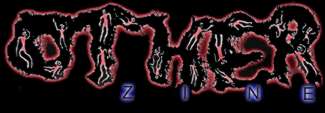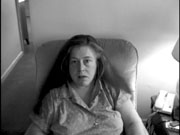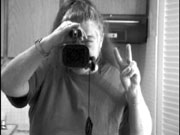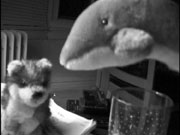
Anne Charlotte Robertson at Squeaky Wheel
by Bernie Roddy
Click here for printable version
At the end of Anne Charlotte Robertson's residency at Squeaky Wheel, conducted between November 16 and 28, 2001, she screened a diary tape produced in the course of her stay. In Artist's Residency, running approximately 30 minutes, Robertson speaks into the camera and reviews the circumstances of her visit to Buffalo. The experience of this tape in the context of a residency screening achieved the effect of a hoax or mistake, a residency gone wrong, an abuse of artistic resources for a kind of medical relief. She learns the use of the digital camera, remarks on her hotel accommodations, and documents an exchange of applauses she requests from the staff and produces for the screening audience. There is no sense of a creative mediation between artist and audience. Robertson's presence is palpable, and her address to us in the audience virtually indistinguishable from one she might make in person.
 In the tape
she returns to the themes of vegetarianism, food, God, and her own sexual
desirability examined in the course of her electronic diary, Five Year
Diary, reports of continual physical pain, relates her hopes and dreams
for finding love during the residency, and shares what she calls the two
fantasies of filmmakers. These are a departure from a fantasy recorded
over ten years earlier in her diary in which her “true love” is found
and discovered to have made a diary that synchronizes with her own. She
relates these new fantasies in video this time, a medium unfamiliar to
her. With the camera directed at her speaking face, she requests us to
attend to for the thoughts that might cross it rather than the beauty
missing from it. In the first, she says, she wakes up and the camera is
alive, with its own needs and desires. The longing she has often expressed
in the earlier diary material for becoming a wife and mother is here gratified
through a transformation of the recording apparatus itself, but it is
a fantasy with all the qualities of a child-rearing nightmare. In the
second, she is on a beautiful cliff with rolling hills and singing sheep
behind her. She contemplates these, camera in hand, and proceeds to throw
the camera to the rocks below. In the context of a dozen years of autobiographical
recording, struggling with mental illness and the psychiatric establishment,
this represents a drop in her usual pretense to hope, an abandonment of
an hitherto unshaken faith in the prospect of rescue.
In the tape
she returns to the themes of vegetarianism, food, God, and her own sexual
desirability examined in the course of her electronic diary, Five Year
Diary, reports of continual physical pain, relates her hopes and dreams
for finding love during the residency, and shares what she calls the two
fantasies of filmmakers. These are a departure from a fantasy recorded
over ten years earlier in her diary in which her “true love” is found
and discovered to have made a diary that synchronizes with her own. She
relates these new fantasies in video this time, a medium unfamiliar to
her. With the camera directed at her speaking face, she requests us to
attend to for the thoughts that might cross it rather than the beauty
missing from it. In the first, she says, she wakes up and the camera is
alive, with its own needs and desires. The longing she has often expressed
in the earlier diary material for becoming a wife and mother is here gratified
through a transformation of the recording apparatus itself, but it is
a fantasy with all the qualities of a child-rearing nightmare. In the
second, she is on a beautiful cliff with rolling hills and singing sheep
behind her. She contemplates these, camera in hand, and proceeds to throw
the camera to the rocks below. In the context of a dozen years of autobiographical
recording, struggling with mental illness and the psychiatric establishment,
this represents a drop in her usual pretense to hope, an abandonment of
an hitherto unshaken faith in the prospect of rescue.
 What this
suggests is a shift in the relation Robertson has with the camera, one
parallel to that which psychoanalytic technique underwent subsequent to
Sandor Ferenczi's challenges to the Freudian reliance on transference.
Transference for Freud's followers names the method by which the patient
responds to the analyst in ways appropriate to past figures of the patient's
life. The emotional force of the response is not explained by the analyst's
behavior. Such transference provides the analyst the opportunity to guide
the patient back into emotional circumstances ripe for analysis. Ferenczi
was a close friend of Freud's and a highly regarded contributor to the
psychoanalytic theory. In his last years he began to advocate consolation
during analysis, dropping the guise of insight in favor of motherly expressions
of love.
What this
suggests is a shift in the relation Robertson has with the camera, one
parallel to that which psychoanalytic technique underwent subsequent to
Sandor Ferenczi's challenges to the Freudian reliance on transference.
Transference for Freud's followers names the method by which the patient
responds to the analyst in ways appropriate to past figures of the patient's
life. The emotional force of the response is not explained by the analyst's
behavior. Such transference provides the analyst the opportunity to guide
the patient back into emotional circumstances ripe for analysis. Ferenczi
was a close friend of Freud's and a highly regarded contributor to the
psychoanalytic theory. In his last years he began to advocate consolation
during analysis, dropping the guise of insight in favor of motherly expressions
of love.
These developments in psychoanalytic technique suggest a corresponding shift in video spectatorship where the diaristic urge is evident. If one teaches video production to children, one will be struck by the constant urge, even in small children, to approach the lens and look into it, without any anticipation of what the visual record will be like. The camera seems to draw out infantile identifications with some imaginary audience or camera operator. But it also raises the camera subject's capacity to sense the spectator's desires. For Ferenczi there is a sensitivity and responsiveness on the part of the victim of a childhood rape that is directed at an original seducer during analysis and bears the qualities of an anxiety-ridden clairvoyance. The object of free association is no longer any sort of benefits to the speaker's health.
 All of Robertson's
electronic diaries have her speaking for the adult world to the world
of children. It is as if she regresses to the creative equivalent of the
oral stage, that at which bare recording has a nourishing or comforting
effect and at which reiterating the objectives she falls short of brings
a sense of, however limited, of well-being. This is particularly evident
in her residency tape, where she has regressed to a fixation on this first
experience with recording equipment. The equivalent of the genital stage
for the filmmaker would be narrative film production. Robertson's tape,
by contrast, has the transparent purpose of serving as a personals ad,
putting on display the degree to which her life falls short of what, she
seems to suggest, everyone has a right to enjoy, in the hope of drawing
the benevolent attention of a greater power. Her resignation at having
been handed this fate is rehearsed again and again in the form of various
mystical and fore-ordained outcomes. She reviews Chinese fortune cookie,
for example, in the context of settling for more food in place of sex.
Thus, Robertson depends upon the bathos of her life to obtain whatever
satisfaction she obtains from others. The whinny, drugged quality of her
voice throughout her diary work continually reminds us of the suckling
she receives from the camera. Much of her Super 8 material had accumulated
for years before she processed it, again suggesting that the camera itself,
rather than the record it inscribes, is what brings satisfaction. The
editing impulse is very weak in her. And the lessons she fails to implement
(to practice vegetarianism, for example, or to stop smoking) serve as
strategies for returning her to this period of teething. Her residency
video, Artist's Residency, places great pressure on viewers to adopt an
attitude of compassion, but the level of calculation she reaches undermines
its effectiveness.
All of Robertson's
electronic diaries have her speaking for the adult world to the world
of children. It is as if she regresses to the creative equivalent of the
oral stage, that at which bare recording has a nourishing or comforting
effect and at which reiterating the objectives she falls short of brings
a sense of, however limited, of well-being. This is particularly evident
in her residency tape, where she has regressed to a fixation on this first
experience with recording equipment. The equivalent of the genital stage
for the filmmaker would be narrative film production. Robertson's tape,
by contrast, has the transparent purpose of serving as a personals ad,
putting on display the degree to which her life falls short of what, she
seems to suggest, everyone has a right to enjoy, in the hope of drawing
the benevolent attention of a greater power. Her resignation at having
been handed this fate is rehearsed again and again in the form of various
mystical and fore-ordained outcomes. She reviews Chinese fortune cookie,
for example, in the context of settling for more food in place of sex.
Thus, Robertson depends upon the bathos of her life to obtain whatever
satisfaction she obtains from others. The whinny, drugged quality of her
voice throughout her diary work continually reminds us of the suckling
she receives from the camera. Much of her Super 8 material had accumulated
for years before she processed it, again suggesting that the camera itself,
rather than the record it inscribes, is what brings satisfaction. The
editing impulse is very weak in her. And the lessons she fails to implement
(to practice vegetarianism, for example, or to stop smoking) serve as
strategies for returning her to this period of teething. Her residency
video, Artist's Residency, places great pressure on viewers to adopt an
attitude of compassion, but the level of calculation she reaches undermines
its effectiveness.